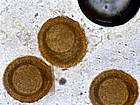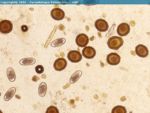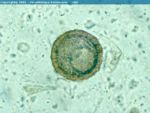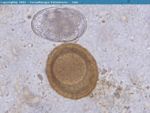Difference between revisions of "Parascaris equorum"
| Line 1: | Line 1: | ||
{{review}} | {{review}} | ||
| − | |||
{{Taxobox | {{Taxobox | ||
|name = ''Parascaris equorum | |name = ''Parascaris equorum | ||
| Line 16: | Line 15: | ||
==Introduction== | ==Introduction== | ||
| − | |||
[[Image:Parascaris equorum.jpg|thumb|right|150px|''Parascaris equorum'' - Joaquim Castellà Veterinary Parasitology Universitat Autònoma de Barcelona]] | [[Image:Parascaris equorum.jpg|thumb|right|150px|''Parascaris equorum'' - Joaquim Castellà Veterinary Parasitology Universitat Autònoma de Barcelona]] | ||
[[Image:Parascaris equorum2.jpg|thumb|right|150px|''Parascaris equorum'' - Joaquim Castellà Veterinary Parasitology Universitat Autònoma de Barcelona]] | [[Image:Parascaris equorum2.jpg|thumb|right|150px|''Parascaris equorum'' - Joaquim Castellà Veterinary Parasitology Universitat Autònoma de Barcelona]] | ||
[[Image:Parascaris equorum3.jpg|thumb|right|150px|''Parascaris equorum'' - Joaquim Castellà Veterinary Parasitology Universitat Autònoma de Barcelona]] | [[Image:Parascaris equorum3.jpg|thumb|right|150px|''Parascaris equorum'' - Joaquim Castellà Veterinary Parasitology Universitat Autònoma de Barcelona]] | ||
[[Image:Parascaris equorum4.jpg|thumb|right|150px|''Parascaris equorum'' - Joaquim Castellà Veterinary Parasitology Universitat Autònoma de Barcelona]] | [[Image:Parascaris equorum4.jpg|thumb|right|150px|''Parascaris equorum'' - Joaquim Castellà Veterinary Parasitology Universitat Autònoma de Barcelona]] | ||
| − | |||
''P. equorum'' is a [[Nematodes|nematode]] that primarily affects younger horses, usually under two years of age, as their immune response is not as developed as older horses. | ''P. equorum'' is a [[Nematodes|nematode]] that primarily affects younger horses, usually under two years of age, as their immune response is not as developed as older horses. | ||
| − | + | Predilection site: '''Small intestine | |
| − | |||
| − | |||
| − | |||
| − | |||
| − | |||
| − | |||
| − | |||
==Hosts== | ==Hosts== | ||
| Line 46: | Line 36: | ||
The prepatent period of ''P. equorum'' is 10-16 weeks. | The prepatent period of ''P. equorum'' is 10-16 weeks. | ||
| − | |||
May cause [[Ascarid Impaction - Horse|Ascarid Impaction]] in horses. | May cause [[Ascarid Impaction - Horse|Ascarid Impaction]] in horses. | ||
| Line 53: | Line 42: | ||
[[Horse_Nematode_Flashcards|Horse Nematode Flashcards]] | [[Horse_Nematode_Flashcards|Horse Nematode Flashcards]] | ||
| + | |||
| + | ==Literature Search== | ||
| + | [[File:CABI logo.jpg|left|90px]] | ||
| + | |||
| + | |||
| + | Use these links to find recent scientific publications via CAB Abstracts (log in required unless accessing from a subscribing organisation). | ||
| + | <br><br><br> | ||
| + | [http://www.cabdirect.org/search.html?rowId=1&options1=AND&q1=%22Parascaris+equorum%22&occuring1=title&rowId=2&options2=AND&q2=&occuring2=freetext&rowId=3&options3=AND&q3=&occuring3=freetext&x=32&y=11&publishedstart=yyyy&publishedend=yyyy&calendarInput=yyyy-mm-dd&la=any&it=any&show=all ''Parascaris equorum'' publications] | ||
| + | |||
| + | |||
[[Category:Ascaridoidea]][[Category:Horse_Nematodes]] | [[Category:Ascaridoidea]][[Category:Horse_Nematodes]] | ||
Revision as of 14:03, 4 October 2010
| This article has been peer reviewed but is awaiting expert review. If you would like to help with this, please see more information about expert reviewing. |
| Parascaris equorum | |
|---|---|
| Class | Nematoda |
| Super-family | Ascaridoidea |
| Species | Parascaris equorum |
Introduction
P. equorum is a nematode that primarily affects younger horses, usually under two years of age, as their immune response is not as developed as older horses.
Predilection site: Small intestine
Hosts
Horses and donkeys.
Identification
P. equorum is a large stout nematode, with the female capable of growing up to 40cm in length. The adults have a mouth surrounded by three large lips. The egg is spherical, brown and has a thick outer shell.
Life-Cycle
The adults live unattached in the small intestine. In heavy infections, they may form large balls, which can cause intestinal obstruction. Under optimal conditions L2 can develop in 14 days. The host ingests the embryonated egg. L2 larvae then pass through the intestinal wall, and transform into L3. The larvae then migrate to the liver via the hepatic portal vein, where they stay for around a week. They enter the vena cava and travel to the pulmonary alveoli, where they transform to L4.
The larvae travel up bronchi to the trachea and are coughed up and swallowed. Finally they return to the stomach and small intestine, where they mature into adults.
The prepatent period of P. equorum is 10-16 weeks.
May cause Ascarid Impaction in horses.
Test yourself with the Horse Nematode Flashcards
Literature Search
Use these links to find recent scientific publications via CAB Abstracts (log in required unless accessing from a subscribing organisation).
Parascaris equorum publications




